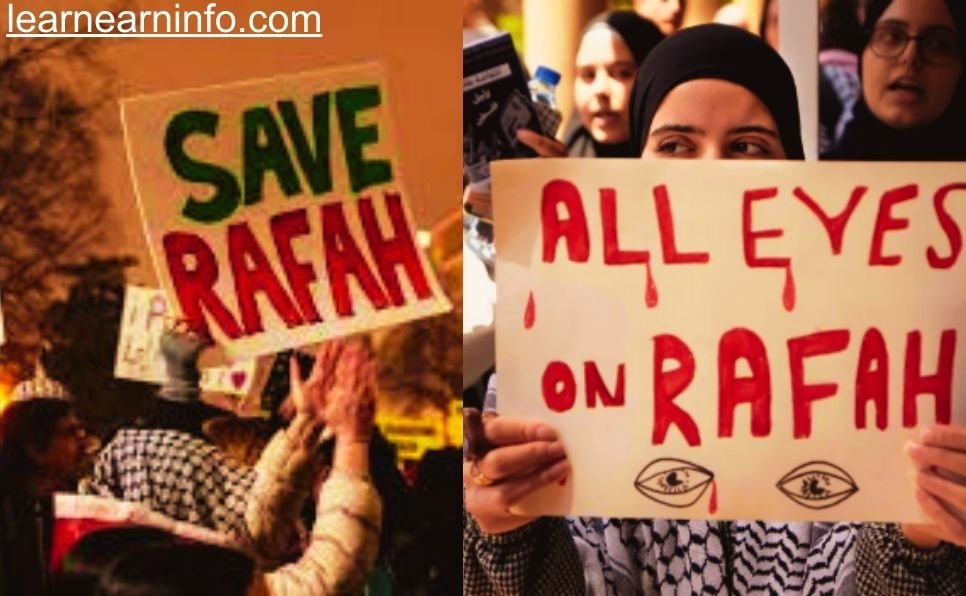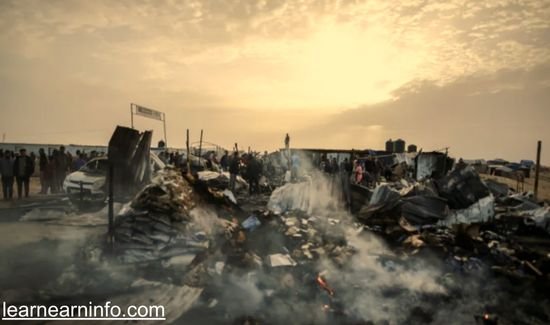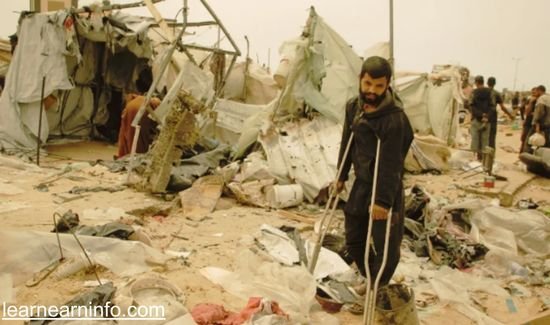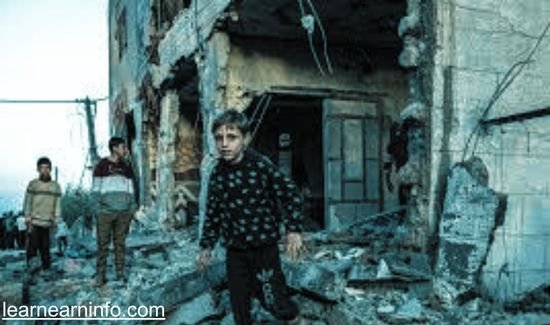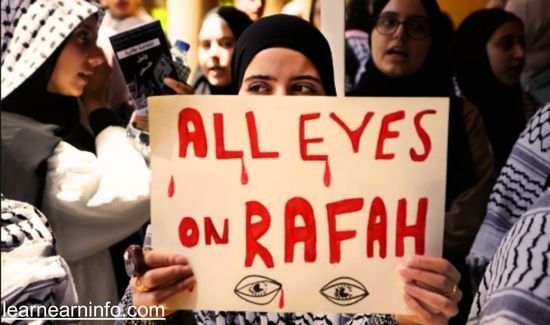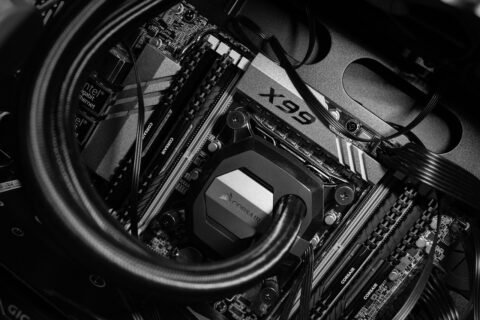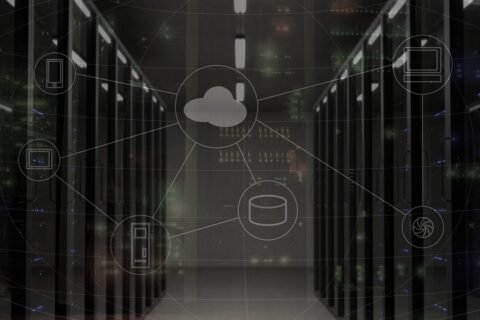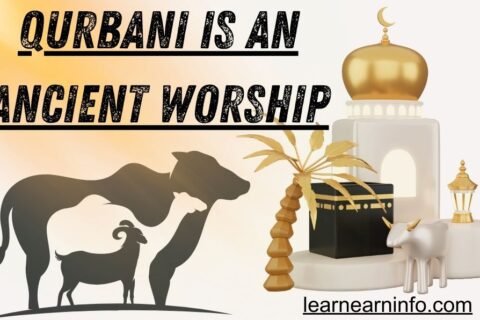All eyes on Rafah: But why? .The Rafah border crossing, a crucial point between Egypt and the Gaza Strip, often finds itself at the center of global attention. As we explore the significance of Rafah, we’ll uncover why all eyes are on Rafah and the complexities surrounding this pivotal region.
Introduction
What makes Rafah so significant that it captures global attention? The phrase ‘All eyes are on Rafah’ resonates not just with those in the region but with people worldwide who recognize its strategic, humanitarian, and political importance. In this guide, we will delve into the factors that make Rafah a focal point for international interest, examining its historical context, humanitarian challenges, and political dimensions.
The Strategic Importance of Rafah
Rafah as a Gateway
Rafah serves as the primary crossing point for goods and people between Egypt and Gaza. Its strategic location makes it a lifeline for Gaza, influencing everything from daily life to geopolitical strategies. For many, it represents the only gateway to the outside world, making its operational status critical for the residents of Gaza.
Key Points About Rafah
- Geopolitical Significance: Controls the movement of people and goods, which directly impacts regional stability.
- Humanitarian Impact: Acts as a critical entry point for aid, which is vital for addressing the humanitarian needs of Gaza’s population.
- Economic Role: Vital for Gaza’s economy, as it enables trade and access to essential goods that are otherwise limited due to blockades.
The Historical Context
Rafah’s history is deeply intertwined with the broader Israeli-Palestinian conflict. Understanding this history is essential to grasp why **all eyes are on Rafah** during times of heightened tension. The crossing has been a point of contention and cooperation over the years, influenced by various political agreements and conflicts.
Historical Timeline
|
**Quote: ** “Rafah is not just a crossing; it’s a symbol of hope and conflict.”
Geopolitical Dynamics
The geopolitical dynamics around Rafah involve multiple stakeholders, including Egypt, Israel, the Palestinian Authority, and various international organizations. Each has its own interests and policies regarding the crossing, which can influence its operational status and impact on Gaza.
**Key Takeaway:** Rafah’s strategic location makes it a vital point for both humanitarian aid and geopolitical maneuvering.
Humanitarian Challenges
Rafah and Humanitarian Aid
Rafah often becomes the focal point during humanitarian crises. Its operation can mean the difference between life and death for many Gazans. When the crossing is open, it allows for the delivery of much-needed humanitarian aid, including food, medicine, and other essential supplies.
Humanitarian Aid Statistics
| Year | Aid Delivered (tons) |
|---|---|
| 2018 | 20,000 |
| 2019 | 18,500 |
| 2020 | 22,000 |
Key Takeaway: The operation of the Rafah crossing directly affects the well-being of Gaza’s population.
Impact on Daily Life
The functioning of Rafah impacts daily life in Gaza. When the crossing is open, it brings relief and hope. When closed, it results in shortages and despair. For residents of Gaza, the status of the Rafah crossing can determine access to necessities and opportunities for economic activity.
Daily Life Aspects Affected
- Healthcare: Access to medical treatments and supplies.
- Education: Ability for students to study abroad or access educational materials.
- Economy: Movement of goods and economic transactions.
- Family Reunification: Opportunities for families separated by the border to reunite.
- Original Viewpoint: Every opening of Rafah is a glimpse of hope for families waiting for medicine and food.”
Case Study: Humanitarian Impact
Consider the situation during a recent conflict where the Rafah crossing was closed for several days. The closure led to a significant humanitarian crisis, with hospitals running out of essential supplies and families struggling to find food and water. International organizations had to negotiate tirelessly to reopen the crossing, highlighting its critical importance.
Key Takeaway: The Rafah crossing is a lifeline for Gaza, and its closure can exacerbate humanitarian crises.
Political Dimensions
International Attention
Why do **all eyes turn to Rafah** during international conflicts? The crossing is often seen as a barometer for the broader Israeli-Palestinian conflict. Its status can reflect the current state of relations between various parties involved and indicate potential developments in the conflict.
Political Reactions
- United Nations: Frequently calls for the crossing to remain open for humanitarian reasons, emphasizing the need for unimpeded access.
- Egypt: Balances its national security with humanitarian concerns, often negotiating terms of operation based on security assessments and international pressure.
- Israel: Monitors and influences the operations for security reasons, considering the potential for smuggling and other security threats.
Quote: “The larger geopolitical struggles in the Middle East are micro cosmoses in Rafah.”
Diplomatic Efforts
Numerous diplomatic efforts focus on keeping Rafah open to ease the humanitarian situation in Gaza. These efforts often involve negotiations between Egypt, Israel, and Palestinian authorities. International mediators, such as the United Nations and various NGOs, play critical roles in these negotiations.
Key Diplomatic Initiatives
- Ceasefire Agreements: Often include provisions for the operation of the Rafah crossing to ensure the flow of humanitarian aid.
- Humanitarian Corridors: Established during conflicts to allow safe passage of aid through Rafah.
- Bilateral Talks: Between Egypt and Palestinian authorities to determine operational terms and security measures.
Key Takeaway: Diplomatic negotiations surrounding Rafah are crucial for regional stability.
Impact on Regional Politics
The operation of the Rafah crossing has broader implications for regional politics. It can influence Egypt’s relations with other Arab states, Israel’s security policies, and the overall dynamics of the Israeli-Palestinian conflict. For instance, periods of heightened tension at Rafah often correspond with broader regional conflicts and diplomatic efforts.
Key Takeaway: Rafah’s operation is a critical factor in regional politics, affecting multiple stakeholders and their policies.
The Future of Rafah
Potential Developments
The future of Rafah remains uncertain but hopeful. Potential developments could transform its role in the region. Key stakeholders are exploring ways to ensure its continuous operation, improve its infrastructure, and address security concerns.
Future Scenarios
- Increased Cooperation: Enhanced coordination between Egypt, Israel, and Palestinian authorities could lead to more stable and predictable operations.
- Technological Upgrades: Improved infrastructure, including modern security and monitoring systems, could facilitate smoother and safer operations.
- Permanent Solutions: Long-term agreements to ensure consistent aid flow and minimize disruptions could significantly improve the humanitarian situation in Gaza.
Quote: “The future of Rafah holds the promise of peace and prosperity, contingent on cooperation.”
Long-Term Impact
Sustainable solutions for Rafah could lead to significant improvements in Gaza’s humanitarian situation and overall stability in the region. Long-term stability and reliable operation of the crossing could foster economic development, improve living conditions, and contribute to peace efforts.
Personal Perspective: “A stable Rafah crossing means a brighter future for generations to come.”
Potential Long-Term Benefits
Economic Growth: Improved trade and economic activities.
Healthcare Advancements: Better access to medical supplies and treatments.
Educational Opportunities: Enhanced access to educational resources and opportunities abroad.
Social Stability: Reduced humanitarian crises and improved living conditions.
Conclusion
In summary, **all eyes are on Rafah** because it is more than just a border crossing. It is a vital lifeline, a symbol of hope, and a focal point of international politics. The ongoing efforts to keep Rafah open and functioning smoothly are critical for the well-being of Gaza’s population and regional stability.
Key Takeaways
Rafah’s Strategic Role: Essential for the movement of people and goods between Gaza and Egypt.
Humanitarian Significance: Crucial for delivering aid and improving daily life in Gaza.
Political Attention: Reflects broader geopolitical struggles and diplomatic efforts in the region.
Prospects: Potential for increased cooperation and sustainable solutions to enhance Rafah’s role as a lifeline for Gaza.
FAQ
Why is Rafah so important?
Rafah is a critical border crossing for the movement of people and goods between Gaza and Egypt, impacting humanitarian aid and regional politics.
How does Rafah affect daily life in Gaza?
The operation of Rafah directly affects the availability of goods, medicine, and other essential supplies in Gaza.
What are the main challenges facing Rafah?
Challenges include geopolitical tensions, security concerns, and the need for coordinated international efforts to keep the crossing open.
What are potential future developments for Rafah?
Future developments could include increased cooperation between relevant parties, technological upgrades, and long-term agreements to ensure consistent aid flow.
By understanding the complexities of Rafah, we can better appreciate why **all eyes are on Rafah** and the vital role it plays in the lives of those in Gaza and the broader geopolitical landscape.


